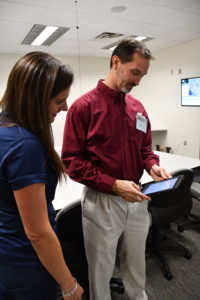AgConnect simulation exercise draws national animal health leaders
Media contact: Blair Fannin, 979-845-2259, [email protected]
COLLEGE STATION – Veterinary health practitioners, federal and state officials, and others from across Texas and the U.S. recently participated in a two-day animal health exercise utilizing AgConnect, a suite of tools used to collect data in the field and analyze it in real time.
The activities included a simulated disease outbreak that demonstrated how syndromic trends from mobile field animal health reports could be monitored for abnormal occurrences. They also included a demonstration on how diagnostic laboratory data feeds, in association with these reports, could reveal what might be happening in affected cattle over a multi-state geography.
“These simulation exercises help all involved have a better understanding of what is possible when multiple animal health observations of varying technical levels are automatically aggregated and presented for analysis, allowing everyone from veterinary practitioners to animal health officials to know when to address an animal health anomaly,” said Dr. Melissa Berquist, director of the Institute for Infectious Animal Diseases in College Station, part of Texas A&M AgriLife Research.


“Our goal is to create greater awareness of what potential threats might be out there, what might be going on and how quickly information can be gathered and analyzed so appropriate steps can be taken to mitigate an epidemic scenario.”
The exercise utilized parts of the AgConnect technology suite, including AgConnect mHealth and AgConnect HealthNet. AgConnect mHealth is a tool that allows for the collection of animal health and production-level data on healthy and sick animals directly from the field with customized mobile applications for different end users including veterinary practitioners, production managers and wildlife biologists. Animal health professionals, such as veterinary practitioners, enter data on tablets or smart phones.
AgConnect HealthNet is a research prototype analyst workstation, which provides permissioned users the capability to integrate and aggregate data streams into an interactive and customizable visual display for analysis. It is part of a pilot project funded by the U.S. Department of Homeland Security Science and Technology Directorate.
Data may be shared anonymously on a permissioned basis among veterinarians, industry personnel and analysts at multiple locations based on established data sharing protocols to provide a complete picture of animal health and anomalies across a geographic region or industry. Both of these tools are part of the Enhanced Passive Surveillance concept, also known as EPS.
“We have a network of veterinary practitioners and production systems already using this tool,” Berquist said. “They collect and gather all of the data in the field. A standard subset of this data is processed and anonymously assigned a location number and filtered appropriately at the zip code, county or regional level to ensure privacy of participants.”
Berquist said the idea is “if they are already collecting this health information on a cattle herd or some type of livestock anyway while out on a call to a farm, that data on type, breed and sex, along with environmental conditions like temperature, can be married with laboratory test results to create a more holistic picture for health and herd management.”
By organizing individually reported information about animal health on a state and regional level, the Enhanced Passive Surveillance system can assist individual veterinarians as well as federal and state animal health officials in identifying emerging trends, said Michelle Colby, veterinarian and program manager, who provided funding for this project from DHS S&T’s Homeland Security Advanced Research Projects Agency.
“The earlier an outbreak is detected and managed, the lower the likelihood it will require federal intervention as part of the response.”
For more information, visit iiad.tamu.edu.


